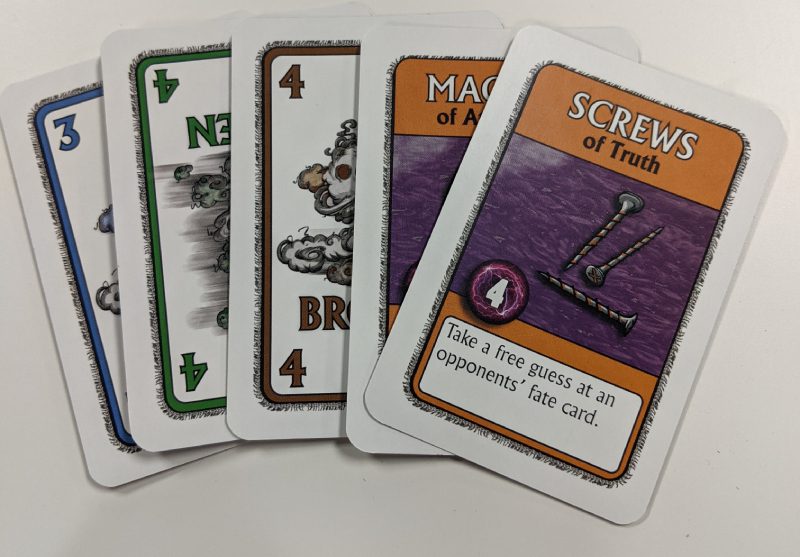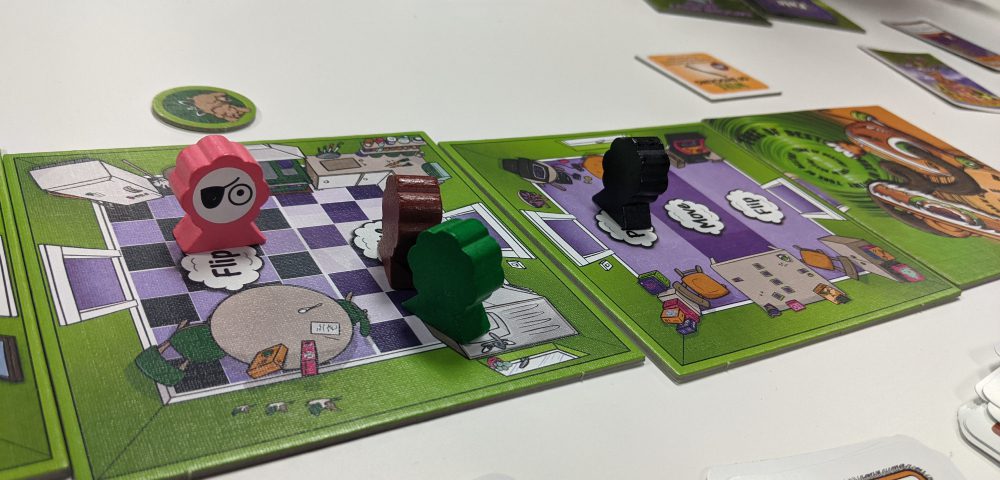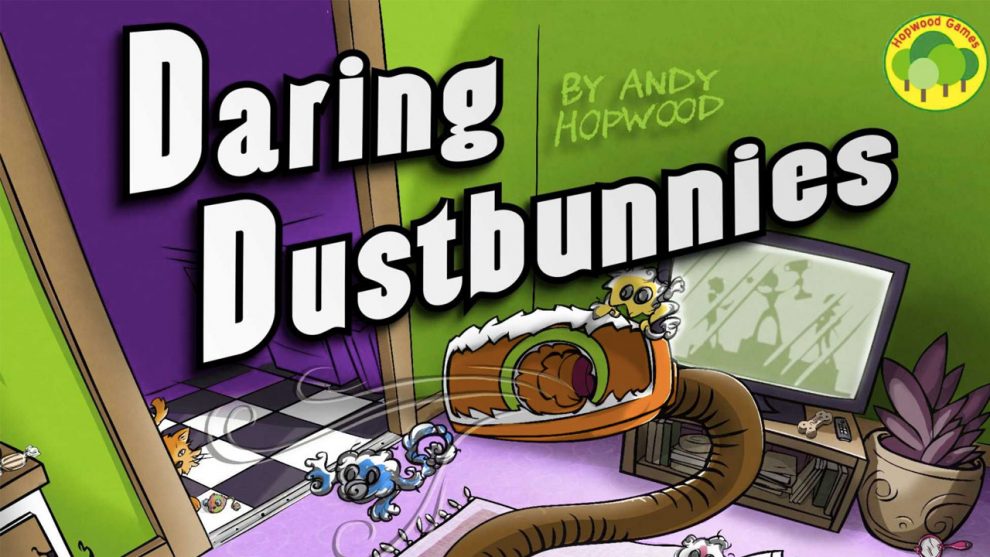Disclosure: Meeple Mountain received a free copy of this product in exchange for an honest, unbiased review. This review is not intended to be an endorsement.
As someone who has been in the board game industry for far too long, very few themes make me pause. Daring Dustbunnies is one of the few games that, after looking at the box and reading the rules, had me saying “What the hell?”
As a Dustbunny, your Fate depends on the performance of one colored Fluffball each round. These Fluffballs will start at one end of the home, and race towards the vacuum residing on the other end. However, getting too close to the vacuum means your Fluffball gets sucked in, thus making you lose all your points. So it’s a race to the finish line, but not cross it.
Okay, I’ll admit, this is a nice change of pace. Like every other modern racing board game, you use cards to move around instead of dice. You start with a handful of cards, and each round, you play one card and do what it says. Most of these cards are movement cards that give you a number and an associated Fluffball, so “Pink 3” means you move the Pink Fluffball exactly 3 spaces.
Wait a minute, you can move other people’s pieces? Yes, you can. The Fate tile, which tells you whose Flufflball you own, is hidden from other players, making this game a race and deduction. Weird mix, but we’ll go with it.

On your marks…
Each space in the home provides you with an action, such as drawing a card, playing another card, or moving another piece. However, if another Fluffball is in that space, you don’t do the action. Instead, you get Static, which is a currency you spend on Gadget cards. Gadget cards are your typical “do what the text says” found in other games. We are talking about cards like Paintbrush of Disguise, which allows you to pick any color when you move a Fluffball, or Marble of Rolling granting you the privilege to play another card.
You also have Dog and Cat cards that give you some extra flexibility to move Fluffballs. Talisman cards are dangerous if you play them alone. If you do, you must reveal your Fate to everyone, but play them in pairs, and you can guess the Fate of an opponent.
The final floor to this construction is the Dustbunnies themselves. Each player will start with a pair of Dustbunnies with a personal power since every game requires asymmetrical powers nowadays. Once all Fluffball pieces are on the board and there are no shared spaces, the round ends.
Everyone reveals their Fate tokens, and medals are awarded according to their position. The three closest to the vacuum will earn a gold, silver, or bronze medal, identical to the Olympics. After three rounds, the game ends, and there are no points here. Instead, you compare who holds the most gold, if there’s a tie, then silver, and if that’s a tie, bronze.

Dust to dust
I’ll confess that I did enjoy the premise this game brings forward instead of a typical roll and move that often comes with these racing board games. Using a deck of cards and giving everyone some form of agency throughout the session.
It also changes things up a notch by packaging the racing portion with deduction. While this isn’t a new concept, as seen in other games like Reiner Knizia’s Winner’s Circle, it is underutilized. There is something primal about moving your pieces across a board, and another layer of this joy comes in when you are trying to figure out which ones belong to your friends. As your fingers caress the wooden pieces, you side-eye your friends to note their reactions as they try their best to put on a poker face. Or if you are facing me, I would intentionally put on a bad poker face just to mess with you.
You might be stroking your chin right now thinking that this sounds interesting because I also had the same thought when I read the rulebook. However, just like a good joke or story, it’s all about the execution, and it’s been a while since I wrote a negative review.
Despite its intentions, this game’s system does not match its objectives. The game wants to be about guessing your friends’ plans, which it attempts to do through a highly chaotic system that feels like a blackmail attempt gone wrong.

There is no web
Conventional wisdom in game design always suggests that deduction games should not have many random elements. Ideally, deduction games should be designed so that a player’s decisions echo their ambitions to other players and provide tools to mislead them.
Daring Dustbunnies simply does not work this way. Instead of dice, you use a handful of cards, and while this does give you some choices, the options are still randomized. Often, this randomization is not consistent with your current objective of moving your fated Fluffball. If my Fluffball is black and my hand of cards does not have a single black card, there is no way anyone would figure me out unless they are Jean Grey or Professor Xavier. The logical connection doesn’t exist.
The randomization problem doesn’t stop with the deduction; it also affects the pacing. The rounds run longer than they should, especially as player count increases since no one has total control of how they move the Fluffballs and the end round condition is very specific. Like debating with a flat earther, it becomes repetitive quickly and overstays its welcome.
The Medals themselves are my final issue with the game. You can grab all of the silver and bronze medals, but if you don’t have a single gold, then you’re out. Although dropping a player in the vacuum might seem a viable tactic to screw over the winning player, the poorly implemented deduction renders this a bad option. During the four sessions I played, no one could figure out who was who.
As cliche as this sounds, there is a silver lining here. While I wouldn’t recommend this game to the gamer crowd, it is a surprisingly good children’s game. Many mainstream board games for kids are often random, such as Candyland, Snakes & Ladders, and Sorry. Daring Dustbunnies is far more engaging than the mainstream crowd, and the only thing I recommend is to take out the Dustbunnies’ powers. Do that, and you have an engaging children’s game.
Nevertheless, there are far better options out there. Daring Dustbunnies is a prime example of why board games need good execution. Even if you have all of the right ideas, it still needs to run well; otherwise, it will fall and hit the ground nose-first before reaching the finish line.











Add Comment